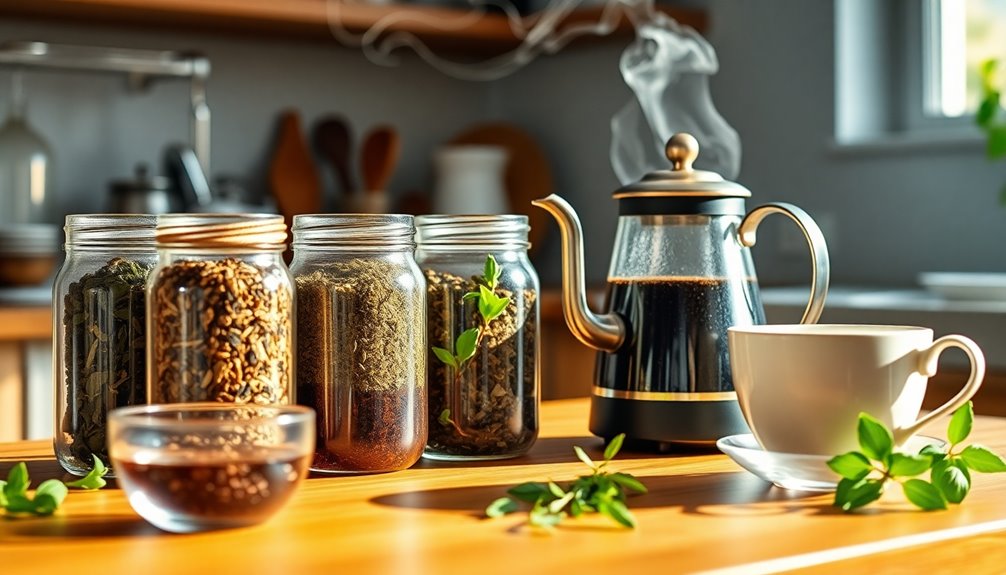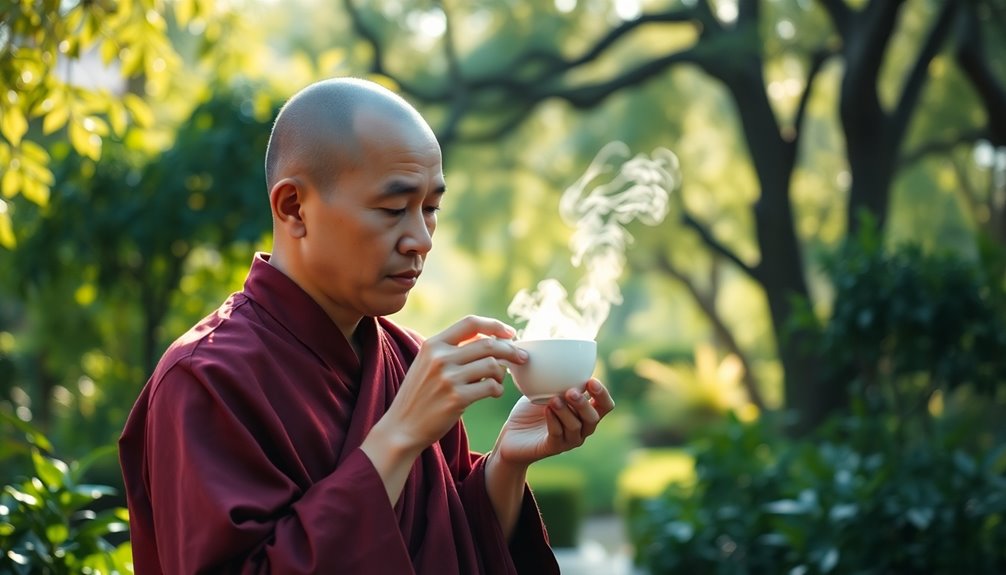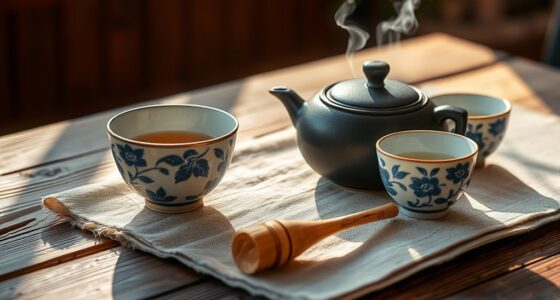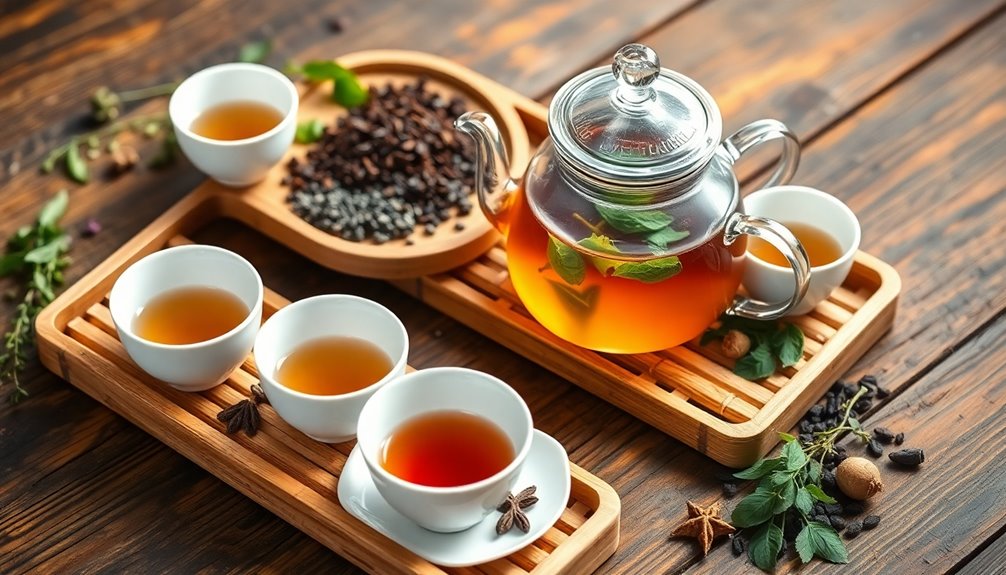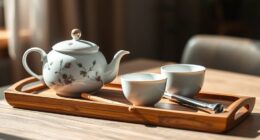Brewing tea like a pro is super fun and easy! First, pick your favorite tea type—black, green, oolong, or herbal. For black tea, use boiling water and steep for 3-5 minutes. Green and white teas love cooler water, so aim for about 175°F and steep for 1-2 minutes. Oolong likes 195°F for 2-3 minutes. Remember, steeping times matter to avoid bitterness! You can even explore cultural tea rituals to make your experience extra special. Plus, tea is packed with health benefits! Keep going, and you'll discover even more tips to become a tea-brewing superstar!
Key Takeaways
- Choose the right type of tea and note its specific brewing temperature and steeping time for optimal flavor extraction.
- Use filtered water to enhance the taste and ensure it is heated to the appropriate temperature for the tea type.
- Measure the correct amount of tea leaves based on the tea type and personal preference, typically 1 teaspoon per cup.
- Steep the tea for the recommended time, avoiding over-extraction to prevent bitterness, especially with delicate teas.
- Enjoy your brewed tea mindfully, appreciating the aroma, flavor, and any cultural rituals associated with the tea type.
Introduction
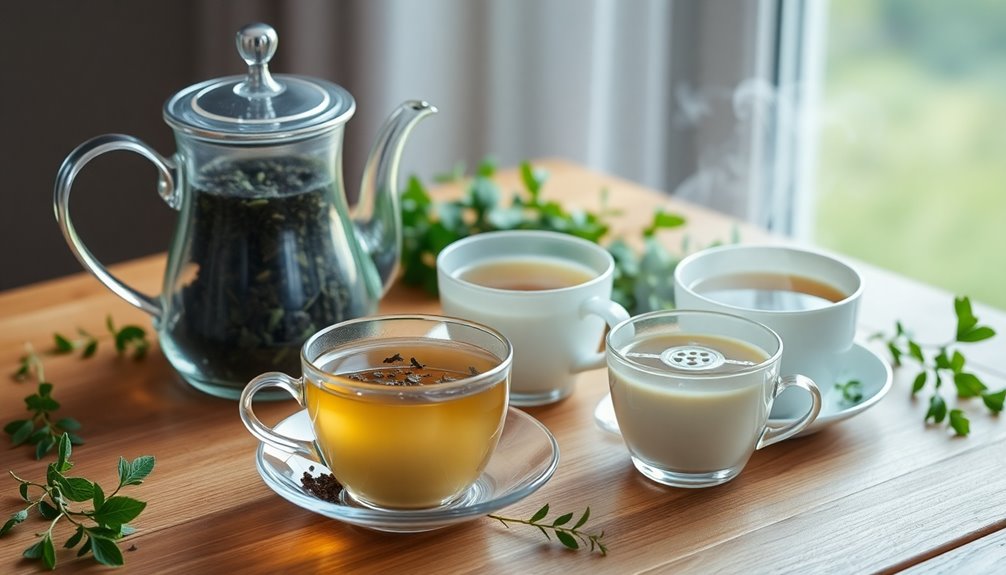
Brewing tea like a pro kicks off with a solid understanding of the five main types: white, green, oolong, black, and dark (pu-erh). Each type of tea has its own unique personality, and knowing them will help you brew a perfect cup of tea every time!
To get started, you'll need some essential tools: loose leaf tea, filtered water, a good brewing vessel like a teapot or mug, and a strainer to catch those lovely leaves.
Water temperature is super important! For instance, black tea loves to be steeped in boiling water at 212°F, while green and white teas prefer a cozy temperature around 175-180°F to keep them from getting bitter.
A handy rule of thumb is to use one teaspoon of loose leaf tea for every six ounces of water, but feel free to adjust the tea-to-water ratio to match your taste.
Steeping times vary too! Black tea typically steeps for 3 to 5 minutes, while green tea is eager to join the party after just 1 to 2 minutes.
With these tips, you're well on your way to brewing delicious tea like a pro! Enjoy your next cup!
Brewing Temperature Affects Flavor

Understanding how brewing temperature affects flavor is crucial for making the most of your tea experience. The right brewing temperature can turn a simple cup of tea into a delightful adventure for your taste buds!
For black tea and herbal teas, you'll want to use boiling water, around 200°F to 212°F, to unlock their robust flavors and aromas. On the flip side, green and white teas are delicate, so brew them at a cooler temperature of 175°F to 180°F. If you use water that's too hot, you risk over-extraction, which can make your tea taste bitter and ruin those subtle flavors you're trying to enjoy.
Oolong teas strike a nice balance, brewing perfectly at 195°F. It's like a warm hug for the leaves! Additionally, some herbal teas, such as chamomile and peppermint, are especially sensitive to brewing time and temperature, affecting their flavor profiles.
After brewing, don't forget to let your tea cool a bit before sipping. This little trick can enhance your flavor experience, allowing you to savor all those unique notes that make each tea special.
Tea Types Influence Brewing Time
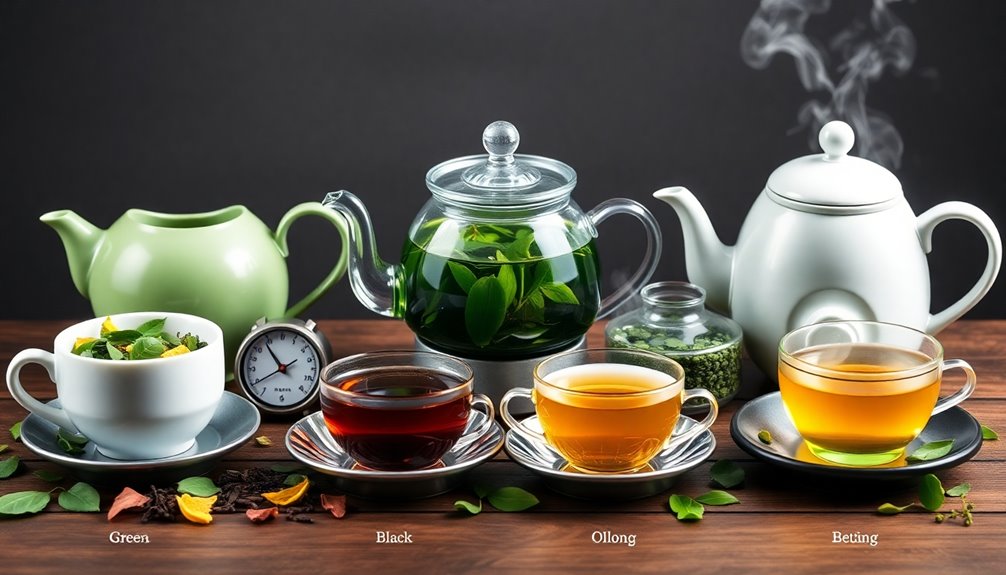
When it comes to steeping tea, knowing the right brewing time for each type can elevate your experience significantly. Different tea types require specific steeping times, so let's dive in!
If you're brewing black tea, it's a robust contender that usually needs 3-5 minutes in hot water. On the other hand, green teas are delicate and only need 1-2 minutes; otherwise, they might turn bitter. Oolong tea is a happy medium, steeping for 2-3 minutes, while white tea, being super gentle, is best steeped for just 1-2 minutes.
Herbal teas and rooibos need a little more time, generally 5+ minutes, to extract all those yummy flavors. Remember, the oxidation level of the tea leaves plays a big role in this! More oxidized teas like black tea can handle longer brewing times, but less oxidized teas like green tea need a little TLC.
To brew the perfect cup, always check the recommended steeping times, then adjust based on your taste. Once your tea's done steeping, don't forget to remove the tea leaves to prevent over-brewing. Happy brewing, tea drinkers!
Cultural Rituals Around Tea
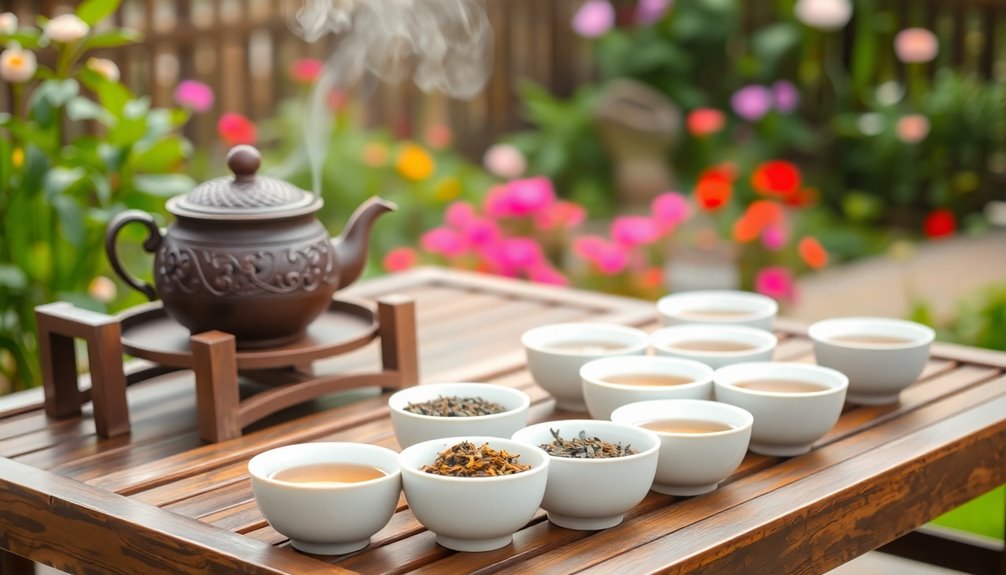
Throughout history, tea has played a vital role in various cultures, shaping rituals that celebrate its significance.
In Japan, the tea ceremony, or "chanoyu," is all about harmony and respect. You'll see the careful tea brewing of matcha, where every step, from whisking to pouring hot water, is done with intention. This creates a peaceful atmosphere and allows participants to enjoy the health benefits of green tea that enhance their overall experience.
In Britain, afternoon tea is a delightful occasion. Picture yourself enjoying sandwiches, scones, and cakes around 4 PM, all served alongside a lovely cup of tea. It's a time for friends to gather and chat!
China has its own charm with the Gongfu tea ceremony. Here, you'll brew loose leaf tea using small teapots, focusing on different water temperatures and short infusions to really taste the tea's unique flavors.
In Morocco, the tea ritual is a lively event! Pouring mint tea from a height creates a frothy top, showing hospitality and friendship during gatherings.
And let's not forget Taiwan, where bubble tea combines brewed tea with fun flavors and chewy tapioca pearls. It's a cultural phenomenon that's made its way around the world! Additionally, the rituals surrounding tea often emphasize mindfulness and respect, reflecting deeper cultural values.
Health Benefits Versus Caffeine Content
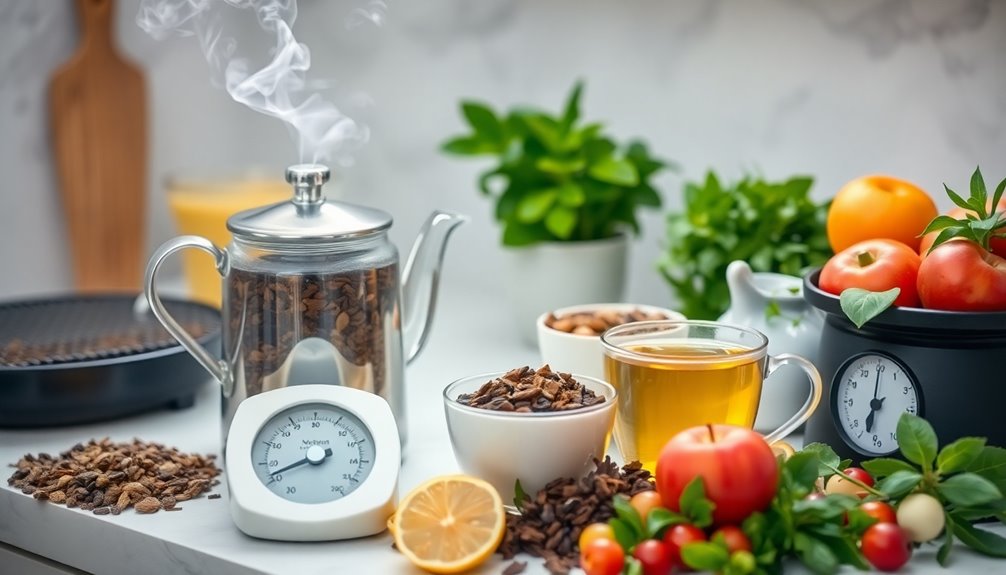
Navigating the balance between the health benefits of tea and its caffeine content is essential for tea lovers. When you sip on black tea, you're enjoying around 40-70 mg of caffeine per 8 oz cup, while green tea has about 20-45 mg. Herbal teas, on the other hand, are caffeine-free, making them a great choice if you want to avoid that buzz!
Now, let's talk about the health perks. Tea is packed with polyphenols, which are powerful antioxidants that help fight off chronic diseases like type 2 diabetes and some forms of cancer. The brewing method you choose can affect these health benefits, so take your time to brew it just right! Oolong tea, with its unique flavor profile, offers a perfect balance of moderate caffeine content and health benefits, making it a delightful choice for tea enthusiasts. Additionally, the type of tea leaves you use can influence caffeine extraction, enhancing the overall quality of your brew.
Moderate caffeine intake from your favorite tea can give you a nice boost in alertness and help with your focus. Just remember, too much caffeine might keep you up at night or make your heart race.
If you're sensitive to caffeine, herbal teas like chamomile or peppermint can provide soothing benefits without the jitters. So, whether you prefer green, black, or herbal, there's a perfect tea for everyone!
Practical Applications
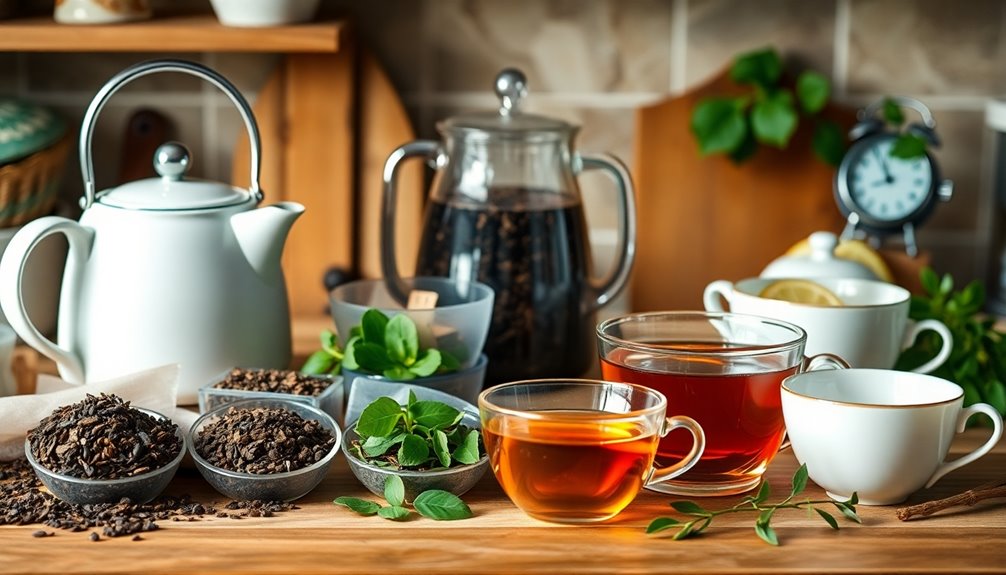
Brewing tea can be a delightful experience, and using the right techniques can elevate your enjoyment. To make the perfect cup, start by measuring one teaspoon of loose tea leaves for every six ounces of water. This balance gives you a yummy flavor!
Next, pay attention to the water temperature—212°F works best for black and herbal teas, while green and white teas prefer 175-180°F. Oolong teas like it around 195°F. Additionally, choosing specific teas like green tea may enhance memory retention due to its beneficial compounds, as they contain antioxidants that combat oxidative stress. Incorporating aromatherapy during your tea brewing ritual can further enhance relaxation and mood; using essential oils like lavender oil can promote a calm atmosphere while you brew.
When it's time to brew your tea, don't forget to steep it for the right amount of time. Black tea takes about 3-5 minutes, while green tea only needs 1-2 minutes. If you steep longer, you might end up with a bitter taste, and nobody wants that!
To keep things cozy, pre-warm your teapot or mug with hot water before brewing. It helps maintain that perfect temperature!
Frequently Asked Questions
How to Brew Tea Like a Pro?
To brew tea like a pro, choose your tea type and measure one teaspoon per six ounces of water. Heat the water to the right temperature, steep according to guidelines, and enjoy experimenting with flavors!
How Do Professionals Make Tea?
Professionals make tea by choosing high-quality loose leaf, measuring the right temperature and steeping time, and using tools like thermometers and timers. They ensure a clear cup by removing leaves promptly after brewing. Enjoy the process!
What Are the Major Steps of Brewing Tea?
To brew tea, gather your tools, heat water to the right temperature, measure your tea leaves, steep for the recommended time, and finally, remove the leaves. Enjoy your cup with optional flavorings!
What Is the Process of Making Tea Step by Step?
To make tea, gather your tools, heat filtered water to the right temperature, measure your loose leaf tea, steep it for the recommended time, and then strain the leaves to enjoy your perfect brew.
Conclusion
Now that you know how to brew tea like a pro, it's time to put your skills to the test! Remember, the right temperature and steeping time can make a world of difference in flavor. Whether you're sipping alone or sharing with friends, enjoy the delightful rituals that tea brings. So, grab your favorite tea leaves, and let's make some magic in a cup! Happy brewing, and may your tea always be just right!

